Via I-MRSEC’s Magnetic Fields Web Series, Youth Discover Magnetism, Diversity in Science
September 19, 2019
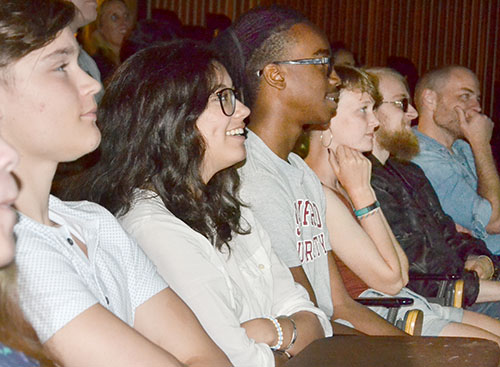
Several Magnetic Fields actors enjoy watching themselves on the “big screen.”
Armed with real theater popcorn and other goodies, the audience at a screening party on August 1st settled back to enjoy Magnetic Fields, a four-part web series the Illinois Materials Research Science & Engineering Center (I-MRSEC) developed as part of its mandate to communicate about Materials Science—in this case, about magnetism. Using a fun plot, plus actors the targeted audience of middle to high school students could identify with, the series sought to capture their interest, possibly directing them along the STEM pipeline into materials engineering. The cast of young actors seated in the front row, excited to see themselves on the “big screen,” reflected the diversity I-MRSEC hopes to foster in the field. Also in the audience, proudly viewing their creation, were the director, John Isberg as well as I-MRSEC’s PI, Nadya Mason, and Outreach Coordinator, Pamela Pena Martin.
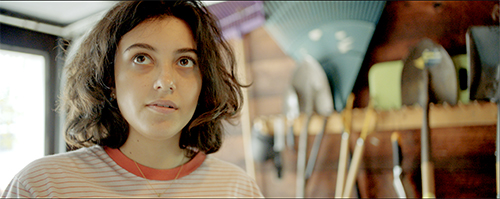
Magnetic Fields screen shot of Jana, played by Neenah Williams. (Image courtesy of John Isberg.)
This was the scenario for Magnetic Fields. A group of ninth graders, including Jana, the main character, have been assigned a group project on magnetism. On a school field trip to I-MRSEC, one of the group, Andy, steals a super magnet from the lab of Jana’s older sister, an Illinois grad student who needs it for an upcoming important meeting with a company she’s always dreamed of working for. Unbeknownst to Jana, the kid stuffs the super magnet into her backpack, causing her to wreak all kinds of havoc: swings mysteriously begin swinging as she passes by; pieces of metal “follow” her when she’s close to them; electronics go wacko. Finally figuring out that a student on the field trip must have "borrowed" her super magnet, the older sister rushes to Jana’s school, where Jana and her group have successfully presented their project. She retrieves the super magnet and gets back to her lab just in time to successfully present her own research.
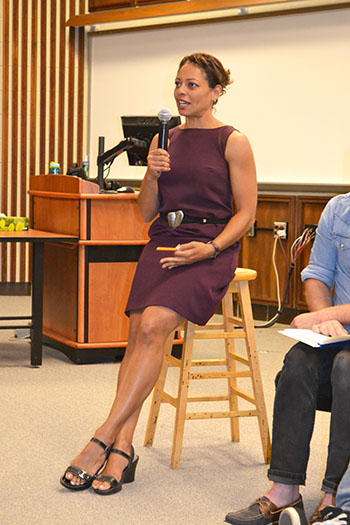
I-MRSEC PI Nadya Mason shares what the center hopes to achieve through the series.
Regarding why I-MRSEC got involved with the project, Pamela Pena Martin explains that “The aim was to engage in science. So there's science content in it. We tried to push things like persistence in science, the scientific process, teamwork, those kinds of things.” In addition, the story line sheds light on the research process and steps to becoming a scientist. Plus, to further encourage viewers towards STEM, each episode features a behind-the-science section at the end, where I-MRSEC scientists share how they got interested in science.
The series was the brainchild of I-MRSEC PI Nadya Mason, who had envisioned creating a video that would be “engaging to an audience that might not typically engage with science content,” recalls Pena Martin. In fact, the notion of creating a web series was actually included in the Center’s original NSF proposal.
“MRSEC was involved from the start,” Pena Martin explains. “We initiated it; we funded it; we were involved in discussing ideas for this script, going over the script editing.”
The director of the series and author of the screen play was John Isberg, a videographer and photographer for the campus’ university housing, who also freelances for Shatter Glass Studios. Though Magnetic Fields was his first web series, he’s done around 30 music videos, several feature films, lots of documentaries, and nine narrative short films. He’s also worked with K–12 kids through Pens to Lens, a program which produces scripts that kids write.
The goal of the series was a product that was not just educational, but entertaining enough to keep kids engrossed. “We had some discussions about what we could make that would be engaging,” Pena Martin explains, “and the idea came to make a scripted series rather than a documentary.”
Of course, they sought a topic that had some relation to I-MRSEC, so they settled on magnetism—materials with magnetic properties. For one, most people know what magnets are.
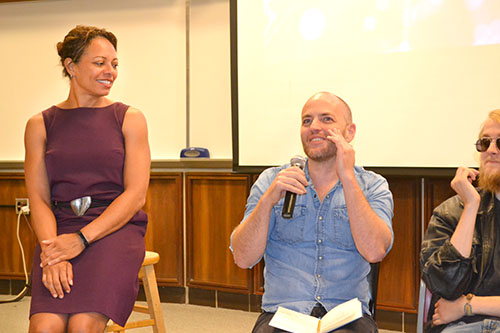
Left to right: I-MRSEC PI Nadya Mason and Magnetic Fields director John Isberg, who is sharing some of the challenges of making the series.
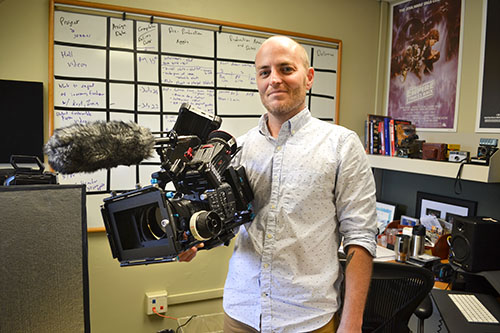
John Isberg with his favorite piece of equipment, the camera he used while filming Magnetic Fields.
“However, they might not know how some of the common technologies around us rely on magnets,” Pena Martin qualifies, “and they may not know what happens if you get a really strong magnet.” So, when, in the plot, Jana’s older sister and her labmate create a “super magnet,” I-MRSEC folks supplied ideas of strange things that might happen. “Like, somebody's walking through a park, swings might go towards them, or anything that's metal would start to pull towards them or move around…and electronics could get all screwed up,” she adds.
Pena Martin claims the audience they were aiming for was middle schoolers: “Because that's the age where there tends to be a drop-off in interest in science. And so we want to try to keep that connection there and build connections.”
The director, John Isberg, who says he and Mason collaborated on the script, agrees with Pena Martin regarding how certain emphases of the plot in regards to women in STEM came about. “Girls tend to lose interest in STEM, (Science, Technology, Engineering, Math) around 15,” he explains. “And so we thought, ‘Why not make something that features a girl prominently as the main character?’" he says.
He goes on to describe how another aspect of the plot came about. "And then I started thinking, ‘Why not show how this girl, at the beginning, maybe she doesn't really feel confident about herself in science. But then, over the course of this series, she grows in confidence and becomes a leader and sees that she's actually good at science.'' And so that'd be kinda cool.”
Having taught middle school special education for four years, working with kids with emotional disabilities, Isberg is familiar with kids’ insecurities.
“I think a lot of the kids that I taught didn't have that confidence in science. It was like they just instantly put up that block to it, like, ‘Oh, I can't, I'm not good at this.’ And so, they never went through with it. But when they actually went and did the hard work, then they saw, ‘Oh, I really like this. Oh, I'm actually good at this!’ And so that was something I wanted to put into the film too.”
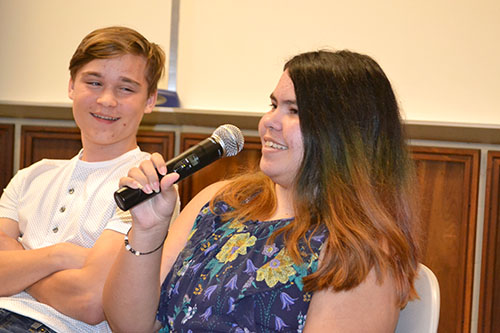
Izzy Gonzalez, who plays Chloe in Magnetic Fields, shares with the audience what acting in the series was like.
Having taught for several years also helped him in terms of character development. “I try to always think of my students and what they might say and kind of pulled from that when writing the characters,” he admits.
For Isberg, writing the script was more “thinking about the actors that came out and then writing more to that role. So I felt like if I saw them as a certain character, I'm like, ‘Okay, this is who you are.’ Because it was more like they're playing themselves in a way.”
When creating the plot, especially the science behind it, Isberg had lots of help from I-MRSEC students, staff, and faculty, many of whom were involved in the planning stages and story development. In fact, a few even made appearances in the videos themselves.
Isberg wrote the bulk of the script, “Except for the scientific,” he confesses, admitting that on some of those passages, “I had Pam and Nadya kind of help me with that—that was kind of their wheelhouse.”

Magnetic Fields screen shot of the group of students at an I-MRSEC open house in MRL. To the right is an actual I-MRSEC senior research scientist, Julio Soares, who is explaining a principle about his research to the students. (Image courtesy of John Isberg.)
In fact, Pena-Martin says she and some I-MRSEC grad students actually met with Isberg several times to brainstorm about the story line of the script. “So we talked about, ‘Okay, what's something interesting that could happen in the lab? It can be a little bit crazy. It's okay if it's stretching the science a little bit. But the idea is something interesting and engaging that we can share that deals with real science.” Of course, they came up with the super magnet scenario.
The I-MRSEC group also provided insight into what the daily life of scientists in a lab is like, and what they might talk about. For instance, in one scene, one grad student asks the other, “Hey, are you going to go to the I-MRSEC Coffee Hour?” which actually happens. It's a meeting where I-MRSEC scientists get together to discuss how their research is going.
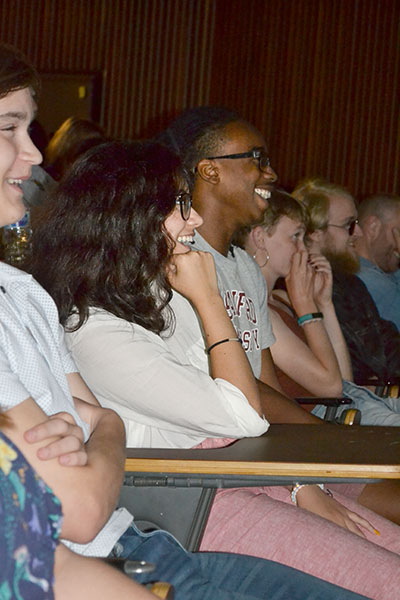
Neenah Williams (second from the left) and Asim Baraka (third from the left) appreciate one of the episodes.
Over the one and a half to two year span from brainstorming to final product, Isberg says he pretty much ate, lived, and breathed the series. In addition to writing the script, he did the directing, cinematography, editing, and sound design. He also helped find the actors, many of whom he’s worked with before.
The cast was chosen with intentionality. To appeal to a young audience and to communicate that science is for all ages, the cast was comprised of mostly young characters—middle and early high school actors. To communicate that people of all ethnicities can become scientists:
“We were intentional about including a diverse cast,” Pena Martin explains. “We want to show the diversity of science, and we hope that most students will find someone in this series that they can identify with.”
So, regarding the script and casting, the I-MRSEC team was not only intentional about having young viewers see someone who looks like them doing science, but they were also intentional about showing women scientists who could serve as role models for girls who might see the series. They sought to show “strong female lead characters as well, just to try to make sure that we're showing what we'd like science to look like and to provide characters for students to connect with,” says Pena Martin.
Even though I-MRSEC was aiming for an audience that might not seek out a documentary, they still wanted to showcase some of their scientists. So at the end of each of the episode a short, behind-the-science clip highlighted I-MRSEC researchers—from undergrad students all the way up through postdocs and faculty, who talked about how they got interested in science or gave advice for young people wanting to pursue science.
“But it just gives a little insight into what the researchers here are like,” she explains, adding that they were “hoping to put a human face to the science.”
Pena Martin stresses that, when choosing the cast for the scripted portion, as well as researchers to share, they sought to highlight the diversity in science and I-MRSEC.

Magnetic Fields screen shot of Renee Harton, an I-MRSEC Postdoctoral Researcher in its IRG-1 and IRG-2 research groups, who shares how she got interested in material science as a young person during one of the "Behind the Science" segments.
“I think the general public often has a narrow image of what a scientist is like and what they do,” she admits, adding that their goal was to “provide a more accurate image of the diversity of the scientific community, including the I-MRSEC- diversity in gender, ethnicity, age, language, interests, area of science they specialize in, and what their research looks like.”
When they began shooting the series, Pena Martin recalls, “Many of the scenes were actually shot here,” By “here,” she means the Materials Research Lab, home of I-MRSEC. In fact, the labs in the series were I-MRSEC labs.
“We actually took the director on tours of our labs ahead of the production, just because we wanted to make sure that it was clear what science labs look like.”
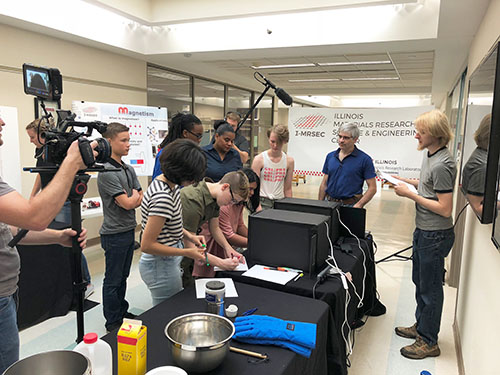
Still shot from an episode of Magnetic Fields; during this scene, the group of students is attending the I-MRSEC Open House held in the Materials Research Lab. (Image courtesy of Pamela Pena Martin.)
She explains that when the general public thinks of a science lab, they often have a mental picture of a chemistry lab lined with shelves of bottles full of different-colored liquids. However, I-MRSEC labs might contain lasers or furnaces or be computational labs, which pretty much just look like offices with computers which researchers use to interact with supercomputers—more virtual labs than physical labs. So they showed Isberg around to give him some ideas of great places to film.
Pena Martin personally found making the series to be quite rewarding, “It was really amazing to see things that were written in the script sort of come alive in front of us,”she shares, acknowledging how amazing it was to “see the ideas that we had—just see them turned into a real thing.”
She also loved sharing the science with the actors: “It was fun talking about the science concepts showing up in the scenes and in their lines in the script. And they were really interested in learning!”
What was the impact of the series? Pena Martin believes “It had a huge impact educationally on many of us,” explaining that it had an impact on several levels. “On one hand, you've got the I-MRSEC people learning how to communicate what we do, and trying to translate it into a movie was actually a really interesting challenge. And then you've got the intended middle-school-to-high-school audience that will be viewing these, maybe using them as an educational tool in classrooms.”
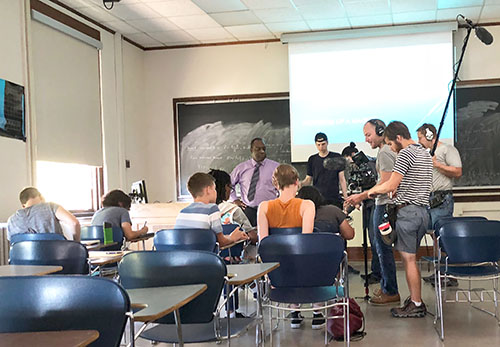
Filming one of the classroom scenes from the series. (Image courtesy of Pamela Pena Martin.
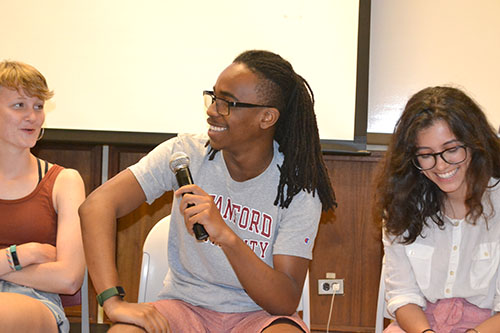
Asim Baraka, who plays Damon in the series, answers a question from the audience during the panel discussion.
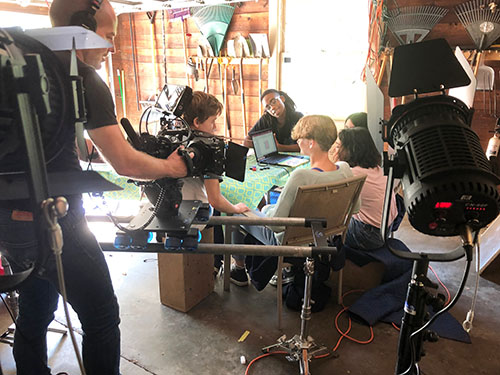
Filming the garage scene from the series where the group is planning their magnetism project. (Image courtesy of Pamela Pena Martin.)
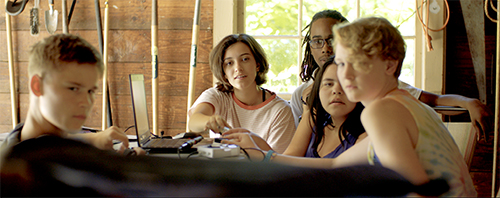
Magnetic Fields screen shot: Students are in the garage, working on their school presentation. (Image courtesy of John Isberg.)
She also believes they got to advocate for science, even among the actors. “Giving them roles like this is actually really valuable because if it sparks their interest, they might start looking for more roles like this. Providing this kind of media is good, to have this kind of content available and being made. So I think it was impactful to the actors participating in it. It was an impactful trip to those most involved in the creation of it. And then again, of course, the main intent is hopefully to educate others as well when they view it.”
The young actors share what they appreciated about doing the series. For instance, Neenah Williams, who played the main character, Jana, says: “I know for a lot of people, science and the STEM fields in general are really scary to go into because they think that everyone is better than them. But don’t let that hold you back, I guess. If you want to learn about it, then learn about it. There’s always more to learn.”
Asim Baraka, who played Damon, admits: “I just like the idea of having it used for education…This is going to be something that’s more entertaining but still teaches you just as much.”
Dema Evans, who played Andy, the kid who filched the super magnet, liked the science. “Learning like the magnetic fields, and all that, how magnets work and how physics works...it’s interesting. You can kind of learn how the world works.”
I-MRSEC plans to disseminate the series through several venues. Since it’s available via You-Tube, the plan is to disseminate info about the series to audiences that might find it useful. For instance, locally, the Center hopes several science teachers at their partner, outreach partners in local schools, will use it in their classrooms. Plus, they have contacts at other schools. In addition, many of the 20 MRSECs throughout the country are doing outreach with middle schools. “So we'll definitely send this to other MRSECs,” she says. Also, NSF could promote this on Twitter, along with several people on campus with pretty strong followings. Teachers from around the country who teach units on magnetism might find it useful as a teaching tool: show the movie, discuss what magnetism is, and how it’s related to electronics.
Is a sequel in the works? Pena Martin says she and I-MRSEC staff are keeping close watch on the number of YouTube views. “We're really interested in seeing how this is taken up,” she says, admitting, “You know, the series ends on a little bit of a hook. So there's this mystery [the disappearance of Jana’s father] that sort of follows along through the episodes and doesn't get resolved entirely.”
She acknowledges that the series was a pretty large-scale project. “It's a huge time commitment to create something like this. It's a huge effort.” While she says the project was cool, they want to see how it's being used. “Is it being used in classrooms?” From some of the schools that use it, she says, “It'd be great to hear their input on how students are engaged by it.” So if it goes viral or, or at least gains a lot of traction, she says there’s a way to continue this, but says, “We've kind of wanted to, before committing to that, we want to see exactly what happens with it.”
Regarding the series itself, she says it’s “beautifully shot,” and says John Isberg, the director, “did just did an amazing job on this. He has a really amazing intuition for filming.” She adds that he also has a lot of experience with science, referring to the fact that he's taught middle school science before and brought that experience into the process.
Isberg’s take on his work might be a bit different. He shares an anecdote about taking a master class about the three phases of film with Ron Howard. Regarding preproduction, the script-writing phase, Howard had said, “So you workshop that to death to the point where you're like, ‘All right, I think we've got something good!’ Then you go into production, and you look at the script, and you're like, ‘Who was the idiot that wrote this thing?’ then, ‘I guess we'll try to do our best.’ So you shoot everything. Then you go into post production where you're editing. Now you look at it, and you're like, ‘Who is the knucklehead that wrote this or that shot this film?’ So I kind of laugh because I was like, ‘Yeah, that's pretty true!’” In this case, of course, Isberg did all three.
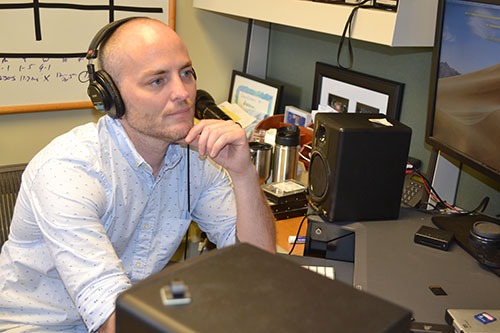
John Isberg doing some post production in his campus office.
After affirming the crew and the cast of actors for a job well done, he adds: “I still feel like this is kind of a crazy honor and makes me very nervous about the fact that this is probably the first narrative series like this that U of I has ever done. So that was super weird. And you know, it's all right.”
Story and photographs by Elizabeth Innes, Communications Specialist, I-STEM Education Initiative.
More: 8-12 STEM Outreach, I-MRSEC, 2019
For more I-STEM articles about I-MRSEC, see:
- I-MRSEC REU Teaches Carmen Paquette a Lot About Magnetism, Research, and Herself
- I-MRSEC REU Exposes Undergrads to Materials Science, Research, and What Grad School Is Like
Magnetic Fields Web Series Trailer. (courtesy of I-MRSEC)
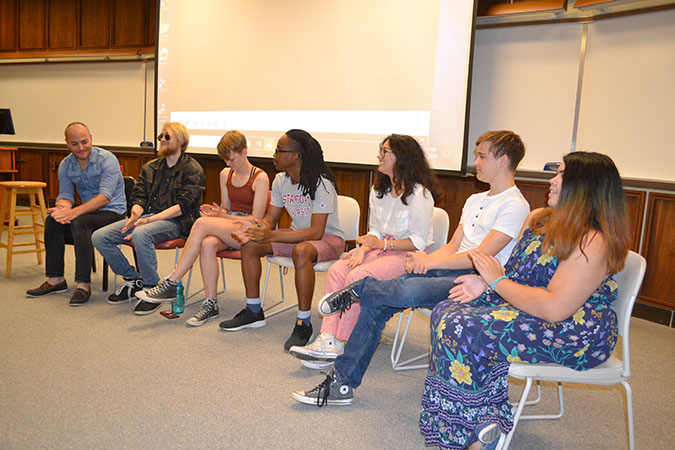
Directors and actors of Magnetic Fields participate in a panel discussion after the screening.













.jpg)
















